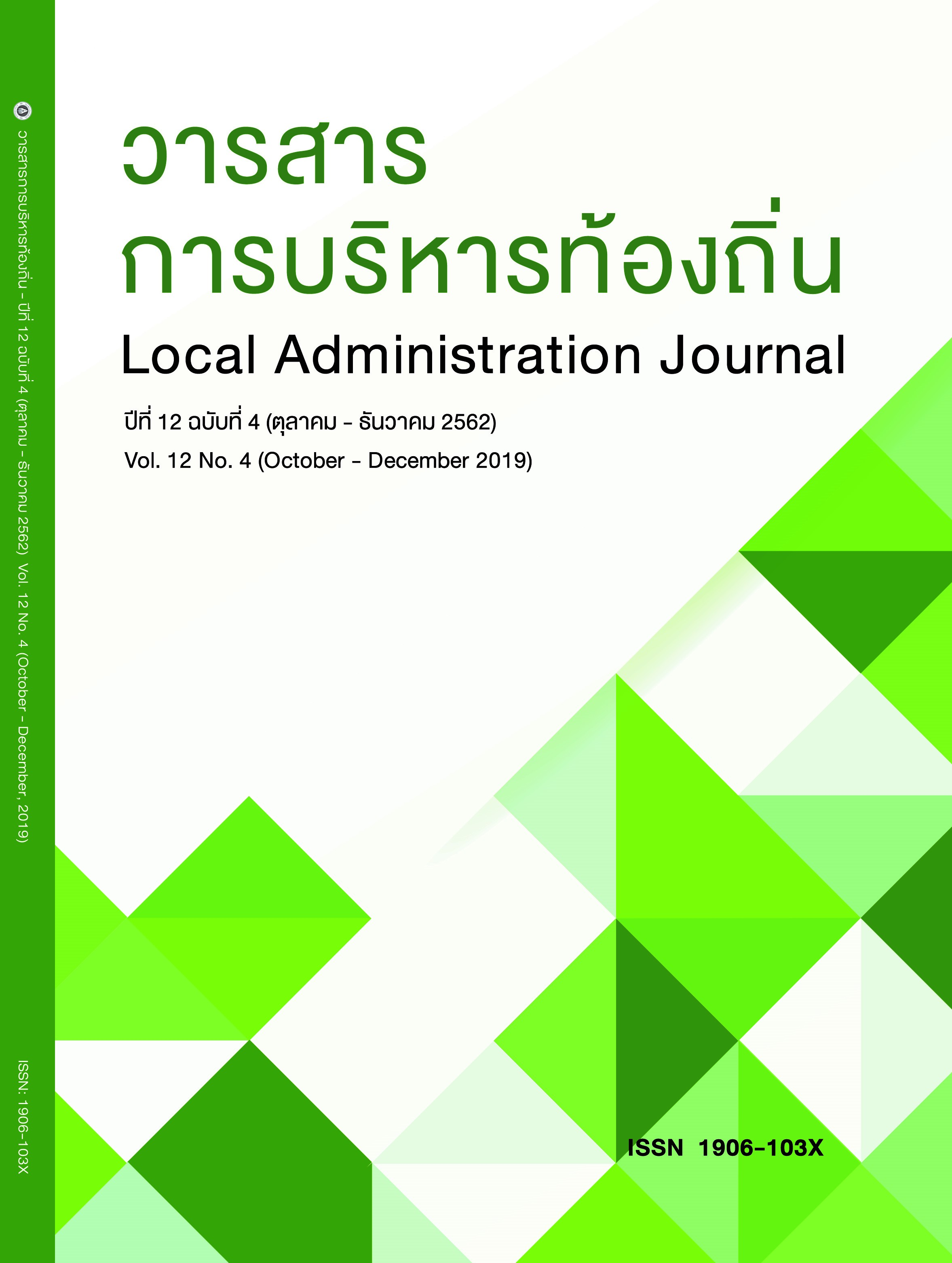The “Syarikat Mati (Death Society)” Welfare Fund of Ban Lahan Community: A Southern Border Social Innovation
Keywords:
Syarikat Mati, Community welfare, Social Innovation and Southern Border CommunitiesAbstract
The objective of this research was to study the model and management of Sarikat Mati Welfare Fund of Ban Lahan in Saiburi District, Pattani Province. The authors employed a qualitative research methodology and collected data from 13 members of the fund who played important roles in driving the welfare via group interviews and observation methods. Data were analyzed for descriptive statistics and content analysis.
The findings indicated that the Syarikat Mati (Death Society) welfare fund of the Ban Lahan community have two forms. First, the Old Form, which managed by the Fund Committee and focused on welfare payments following a death of community members. Second, the New Form, which provides not only death welfare payments but also potential development welfare, and uses participatory management of people in the community, from problem finding, activity planning, investment, operation, monitoring, and evaluation. The Sari Guatamati Welfare Fund, therefore, has been developed and widely accepted, as it responds to social problems and needs. This has resulted in societal changes that connect and integrate the people and the communities based on the Islamic culture.
References
กรมพัฒนาสังคมและสวัสดิการ. (2545). แผนพัฒนาสวัสดิการสังคมและสังคมสงเคราะห์แห่งชาติ ฉบับที่ 4 (พ.ศ. 2545-2549). กรุงเทพฯ. กรมพัฒนาสังคมและสวัสดิการ.
กระทรวงการพัฒนาสังคมและความมั่นคงของมนุษย์. (2559). กระทรวงการพัฒนาสังคมและความมั่นคงของมนุษย์. วันที่ค้นข้อมูล 19 ธันวาคม 2560, จาก https://www.m-society.go.th/article_attach/8409/8635.doc.
โกวิทย์ พ่วงงาม. (2550). การส่งเสริมการมีส่วนร่วมของประชาชนด้านการกระจายอำนาจสู่ท้องถิ่นตามรัฐธรรมนูญ. กรุงเทพฯ: โรงพิมพ์มิสเตอร์ก็อบปี้.
จิรัชยา เจียวก๊ก, วันชัย ธรรมสัจการ, เกษตรชัย และหีม และอุทิศ สังขรัตน์. (2560). การพัฒนารูปแบบการมีส่วนร่วมในการจัดสวัสดิการชุมชนชาวประมงชายฝั่งทะเลอันดามัน. วารสารพัฒนาสังคม, 19(2), 21-35.
จิรัชยา เจียวก๊ก สันติชัย แย้มใหม่ และอุทิศ สังขรัตน์. (2558). โนรากับสุขภาวะของคนและชุมชน. วารสารไทยคดีศึกษา, 12(2), 150-176.
เจะสมาแอ เจะเลาะ. (2560, 18 พฤศจิกายน). ผู้นำชุมชนละหาร. สัมภาษณ์.
ชื่นฤทัย กาญจนะจิตรา และ วาสนา อิ่มเอม. (2544). นวัตกรรม สังคม: การ ให้ ความ หมาย และ ลักษณะ กิจกรรม ใน ประเทศไทย. กรุงเทพฯ: สถาบันวิจัยระบบสาธารณสุข.
ณรงค์ เพ็ชรประเสริฐ. (2546). บทสังเคราะห์ภาพรวมการพัฒนาระบบสวัสดิการสำหรับคนจนและคนด้อยโอกาสในสังคมไทย. ศูนย์ศึกษาเศรษฐศาสตร์การเมือง จุฬาลงกรณ์มหาวิทยาลัย, กรุงเทพฯ.
ปาริชาติ วลัยเสถียร. (2543). กระบวนการและเทคนิคการทำงานของนักพัฒนา. กรุงเทพฯ : โครงการเสริมสร้างการเรียนรู้เพื่อชุมชนเป็นสุข.
ภิญญาพัชญ์ นาคภิบาล และละเอียด ขจรภัย. (2554). การพัฒนารูปแบบการบริหารจัดการกองทุนสวัสดิการชุมชนในเขตพื้นที่อำเภอลาดหลุมแก้ว จังหวัดปทุมธานี. (รายงานวิจัย). สถาบันวิจัยและพัฒนา มหาวิทยาลัยราชภัฏวไลยอลงกรณ์.
มะดาโอะ ปูเตะ. (2554). กองทุนสวัสดิการ “ซารีกัตมาตี” วัฒนธรรมการดูแลสุขภาวะชุมชน มลายู มุสลิมในจังหวัดชายแดนภาคใต้ : กรณีศึกษาชุมชนบ้านโคะ อำเภอยี่งอ จังหวัดนราธิวาส. กรุงเทพฯ: กรมส่งเสริมวัฒนธรรม กระทรวงวัฒนธรรม.
ยะยอ แมแล. (2560, 17 พฤศจิกายน). ผู้นำศาสนาของชุมชนละหาร. สัมภาษณ์.
ระพีพรรณ คำหอม. (2545). สวัสดิการสังคมกับสังคมไทย. กรุงเทพฯ: อารยันมีเดีย.
สถาบันพัฒนาองค์กรชุมชน. (2552). คู่มือการดำเนินการโครงการสนับสนุนการจัดสวัสดิการชุมชน. โรงพิมพ์แอ๊ปป้า พริ้นติ้ง กรุ๊ป, กรุงเทพฯ.
สุภางค์ จันทวานิช. (2554). การวิเคราะห์ข้อมูลวิจัยในเชิงคุณภาพ. (พิมพ์ครั้งที่ 10). กรุงเทพฯ: จุฬาลงกรณ์มหาวิทยาลัย.
สุรวุฒิ ปัดไธสง. (2545). วัฒนธรรมชุมชน: เงื่อนไขความเข้มแข็งชุมชน/หมู่บ้าน. วารสารพฤติกรรมศาสตร์, 8(1), 11-20.
อับดุลรอซีด เจะมะ. (2542). ซารีกัตมาตี วัฒนธรรมการดูแลสุขภาวะของชุมชนมลายูมุสลิมในพื้นทีสามจังหวัดชายแดนภาคใต้. สืบค้นเมื่อ 28 สิงหาคม 2560, จาก https://www.gotoknow.org/posts/633265
อานูวี เจะแม. (2560, 25 พฤศจิกายน). ผู้นำกลุ่มกองทุนซารีกัตมาตี. สัมภาษณ์.
อุทัย ปริญญาสุทธินันท์. (2559). “สวัสดิการชุมชน” ความสมดุลระหว่างการให้และการรับ. วารสารการพัฒนาชุมชนและคุณภาพชีวิต, 4(3), 327–336.
Translated Thai References
Chantawanich, S. (2011). Qualitative research data analysis. (10th eds). Bangkok: Chulalongkorn University. (In Thai)
Community Organization Development Institute. (2009). Implementation Guide for Community Welfare Support Program. Bangkok: Appa Printing Group. (In Thai)
Department of Social Development and Welfare (2002). National Social Welfare Development No. 4 (2002-2006). Bangkok. Department of Social Development and Welfare. (In Thai)
Jaema, A. (1999). Sarigatamati culture, health care in the Malay Muslim community in the three southern border provinces. Retrieved August 28, 2017, from https://www.gotoknow. org/posts/633265 (In Thai)
Jaemea, A. (2017, 25 November). Fund leader, Sarikat Mati. (interview). (In Thai)
Jaloh, J. (2017, 18 November). Community leaders. interview. (In Thai)
Jeawkok, J., Dhammasaccakarnb, W., Laeheemc, K. & Sangkarat, U. (2017). Participatory Development Model for the Andaman Coast. Journal of Social Development, 19(2), 21-35. (In Thai)
Jeawkok, J., Yammai, S. & Sangkarat, U. (2016). Nora and the health of people and communities. Thai Journal of Case Studies, 12 (2), 150-176. (In Thai)
Kanchanachitra, Ch. & Imaim, W. (2001). Social Innovation: Providing meaning and characteristics of activities in Thailand. Bangkok: Health Systems Research Institute. (In Thai)
Khamhom, R. (2002). Social welfare and Thai society. Aryan Media, Bangkok. (In Thai)
Mary, Y. (2017, 17 November). Religious leaders of the community. (interview). (In Thai)
Ministry of Social Development and Human Security. (2016). Ministry of Social Development and Human Security. Retrieved December 19, 2017, from https://www.m-society. go.th/article_attach/8409/8635.doc. (In Thai)
Nakhapiban, P & Khajornpai, L. (2011). Development of community welfare fund management model in Lat Lum Kaeo district Pathum Thani Province. (Research report). Research and Development Institute Valaya Alongkorn Rajabhat University. (In Thai)
Parinyasutinun, U. (2016). "Community welfare" The balance between giving and receiving. Journal of Community Development and Quality of Life, 4(3), 327–336. (In Thai)
Pataisong, S. (2002). Community culture: conditions for strengthening communities/villages. Journal of Behavioral Science, 8(1), 11-20. (In Thai)
Phangngam, K. (2007). Promote public participation in local decentralization. Bangkok: Mister Copy printing. (In Thai)
Phetpasoet, N. (2003). Welfare for the Underprivileged in the Thai Society. Bangkok: Center for Political Economy Studies Faculty of Economics Chulalongkorn University. (In Thai)
Putae, M. (2011). Welfare Fund "Sarigatamati" Culture of Malay Muslim Community Care in the Southern Border Provinces: A Case Study of Ban Ko Community, Yi-ngo District, Narathiwat Province. Department of Cultural Promotion Ministry of Culture. (In Thai)
Rativanih, K. (2010). Innovation Cultural. Retrieved December 18, 2017, from http://www.nia.or.th/innolinks/page.php?issue=201212§ion=4. (In Thai)
Valaisathien, P. (2000). Process and technical work of developers. Bangkok: A project for enhancing learning for the happy community. (In Thai)
Additional Files
Published
How to Cite
Issue
Section
License
The copyright of all articles published in the Local Administration Journalis owned by the College of Local Administration, Khon Kaen University.



